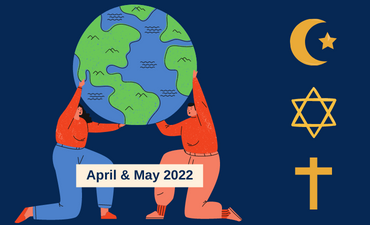
While Anne Arundel County Public Library is not religiously affiliated, we nonetheless encourage our customers in the spirit of lifelong learning to be culturally fluent about the world’s various religions. Over the next month, billions of people around the world belonging to all three Abrahamic religions – Islam, Judaism, and Christianity -- will be celebrating holidays that are considered among the most ‘holy days’ of the year.
First, the Muslim holiday of Ramadan will begin the evening of Friday, April 1 and will end the evening of Saturday, April 30. Then, between the evening of Sunday, May 1 and the evening of Monday, May 2, Muslims will commemorate Eid al-Fitr, the official conclusion of Ramadan and transition back to ordinary life.
Meanwhile, the Jewish holiday of Passover begins the evening of Friday, April 15 and ends the evening of Saturday, April 23, while finally, the Christian holiday of Easter will take place Sunday, April 17.
Ramadan is a month-long Muslim holiday of both solitary prayer and reflection, along with communal fasting and togetherness. Observed during the ninth month of the Islamic lunar calendar, Ramadan is celebrated in order to remember when the Prophet Mohammed first received revelations that eventually became the Quran, Islam’s holy book. Honoring Ramadan by fasting from dawn to sunset each day during its commemoration is so important to practicing Muslims that it is considered one of the five pillars of Islam. Although certain tenets of the holiday are near-universal, such as giving charity or zakāt, there are variations in other aspects of how Ramadan is observed in different regions of the world. For example, in parts of the Middle East, on the fifteenth night of Ramadan (the halfway point), children dress in a traditional style and go door-to-door, much like American Halloween, where they are given nuts and sweets by their neighbors. Eid al-Fitr, or the ‘Breaking of the Fast’ is the final event in the holy month of Ramadan, and is typically full of merriment and recreation
Passover (or Pesah/Pesach in Hebrew) is a 7-8 day Jewish holiday that is observed beginning on the 15th day of the Hebrew month of Nisan, the first full month of spring. It celebrates the Hebrews’ release from slavery in Egypt and is so named because, according to the book of Exodus in the Talmud (the Jewish holy book and also part of the Christian Old Testament), the Lord “passed over” the firstborn of the Israelites during a plague he inflicted on the rest of Egypt, thereby showing mercy to the ancient Jewish people. One of the rituals associated with Passover is to neither eat nor own any food made with leavened (chametz) grains, and so matzah, an unleavened flatbread, has become one of the symbols of the holiday due to its ubiquitous use during that time. Traditionally, Jewish families gather together during the first night of Passover for a meal called a Seder, during which the story of Passover is retold. Children have a key part to play in these meals: the youngest child will usually ask four questions about the seder, beginning with the question ‘Why is this night different from all other nights?’, and the group gathered discusses the answers and the symbols inherent in them.
Easter is the culmination of the Christian season of Lent, a 40-day period during which Jesus Christ is said to have fasted in the desert prior to his crucifixion, death, and subsequent resurrection. Lent is also a period in which observant Christians will themselves give up something and/or add a spiritual discipline as a way to stimulate personal reflection and growth during that sacred time leading up to Easter. The holiday marks the end of what is known as Holy Week, which includes Palm Sunday (one week before Easter), Holy Monday, Tuesday, and Wednesday, Maundy Thursday, Good Friday, Holy Saturday, and finally Easter Sunday. Each day remembers a different aspect of Christ’s final days, and Easter in particular celebrates his coming back to life three days after dying on the cross and being entombed. Technically, Easter Season lasts seven weeks, until the Day of Pentecost, marking when Christ is said to have ascended to Heaven. One of the more playful customs associated with Easter is the hiding of colored eggs, meant to symbolize new life and rebirth.
For more information, we invite you to explore the two curated lists below that will help you learn more about these four holidays and the faiths underpinning them – one for children, and one for adults, teens, and young adults. These lists include books as well as visual media – enjoy!